
May 01, 2010
|
Welcome to May's edition of the Happy Cat Ezine Hope all your kitties are enjoying spring as much as our two are. byron and Shelley spend all their time outside now and can be seen running around chasing insects and climbing trees. Which means i spend a lot of my time calling them in for dinner and preying they don't hurt themselves amongst all the fun they are having. As usual the web site is going from strength to strength and is receiving lots of great submissions from its visitors. Keep them coming. Remember if you have a cat story to tell us or a favorite feline poem to share it with us here. hope you are all well and i hope to see you soon on Our-happy-cat.com. See you next month Best Wishes Kate ------------------------------------------------------------------------------------------------------------------------------------------------ CONTENTS1. New Cat Gallery Photos This Month 2. Competition 3. Byron and Shelley's Latest Diary Entry 4. Cat Story - The Amazingly Intelligent Transatlantic Travelling Hen 5.. Article - Understanding cat pregnancy and how you can help your pet ---------------------------------------------------------------------------------------------------------------------------------------------- 1.New Cat Gallery PagesVisit the cat gallery to see more. Enjoy. Don't forget to submit your cat to the cat gallery so that others can enjoy your cat aswell.
----------------------------------------- 2. Competition Number May29Here is May's Caption Competition. All you have to do is write a caption for this picture. . Simply send us your caption to go with this picture.
The deadline for this competition is May 24th. The best caption will be chosen and the winners name and caption will be posted on the www.our-happy-cat.com competition page.
GOOD Luck
-------------------------------------------------------------------------------- 3. Byron and Shelley's Latest Diary Entry
Of the two Shelley is the more cozy cat, he will happily sit on your lap in the evening or on the bed at night and seems to be happier when we are around. whereas Byron his brother is a far more independent sort all together, although he does demand a game of fetch from us several times a day. i swear he thinks he is a dog some days.
I will be adding regular updates about them on the web site so keep an eye on your RSS feeds for those. Here is their page
-------------------------------------------------------------------------------- 4. Cat Stories and Poemswe like to encourage our visitors to the site to share their cat story or poetry with us here. we certainly enjoy reading your tales of rescue, joy and sadness too. So if you have a story or poem to tell us please let us know HERE The Amazingly Intelligent Transatlantic Travelling Hen by Denise Dresner (London) My parents were living in Vienna and looking after my cat. When they went away on holiday they got a cat-sitter to stay in their flat. In spite of my mother?s instructions, the sitter didn't keep the litter box clean and the cat peed all over the owner's Persian rugs, leaving the pervasive smell of cat urine throughout the flat. My mother decided to ask Eva, the Polish woman who cleaned the flat, for her advice. My mother spoke to Eva in Russian and Eva spoke to her in Polish, and they managed to understand each other quite well. My mother explained the situation with the 'koshka' (the Russian word for cat), the smell, and the need to get the rugs cleaned. Eva asked (with surprise): Did you keep her here in the flat? E (more suprised): Really? I never heard of that! M (puzzled): But of course! They are such nice pets. And vey intelligent too. For instance, mine even knows how to open the front door of the flat. she jumps on the nearby chest and reaches over and manages to press down on the door handle! So we have to be careful to keep the door locked. Eva's eyes widened further. M: And it can be very affectionate too - it often comes and sits - on my lap. E: It sits on your lap? M: Sure they love being petted? E (with a look of total amazement): Petted And so what happened to it? M: My daughter came and took it on the train to Frankfurt and from there put it on the plane for New York. E (by now her eyes were popping out in amazement): She sent it by plane to New York? M: Yes she's very attached to her and wants to have her cat with her. E: Well, I once had one too when we lived in Poland, but we kept it out on the balcony. Now it was my mother's turn to be surprised. M: What, also in the winter? In the cold? E: Yes, it had a little box to live in. M: So, what happened to it? E: Well, one day my father just wrung its neck. M (aghast): What are you talking about? She was horrified, all the more since she knew the woman's father who worked at the same office and was a very nice guy. At that point she realized that there must be some misunderstanding. It turned out that when my mother had said 'koshka' the woman had understood 'kokoshka', which in Polish is the colloquial word for hen. So, whose astonishment was the greater, I wonder my mother's, imagining a poor cat living in a box on a balcony and having its neck wrung, or the Polish woman's, trying to picture a hen deftly operating a door handle and being sent across the Atlantic. ______________________________________________ 5.. Article - Understanding cat pregnancy and how you can help your pet.Un neutered cats are very prolific breeders and can produce three litters a year when left to their own devices. The female cat is usually able to breed from as young as six months old, sometime even younger. The signs of a cat in heat or to use its medical name Oestrus, can be quite subtle and can be easily missed by cat owners. Although there will be some bleeding during this time, it is a lot less noticeable than in a human and if the cat is allowed outside may be missed completely. Usually the first indications that a cat is “on heat” are changes in behaviour. Often the female cat will become overly friendly towards everyone and will rub herself around your legs more frequently than usual. She will also roll around on her back more often, make unusual yowling noises and will want to urinate more often, which helps to spread her scent around. If your female cat does have contact with complete male cats during this time, it is likely that she will mate with all that she encounters. This explains why a litter of kittens may contain many different fur colourations and markings, as they may all have different fathers. The gestation period for a cat is between 60 and 65 days and the first signs that your cat is pregnant may not be evident until the third week of pregnancy, when her nipples will start to become enlarged. By week four the pregnancy should become visible and it during this time that a vet will be able to feel the kittens through her abdomen. During your cats pregnancy it is important that your cat is fed top quality cat food, choosing one that is formulated for kittens is a good choice as it is higher in protein and calcium. However over feeding should be avoided, as over weight cats can suffer complications during birth. Extra vitamins may be beneficial to your pregnant cat, but supplements should not be given without the approval from a qualified vet. As the birth draws near, the queen will start to look for a place to have her kittens. She will probably want to choose a quiet secluded familiar place that is warm and secure. As an owner you can help choose this place by placing a cardboard box lined with newspaper in a quiet warm room. Food, water and a litter tray should also be placed near by to encourage your queen to make this her birthing box. One of the first signs that your cat is preparing to give birth is that her appetite will decrease and she will either begin to want to be on her own more than usual or she may seek out human affection to help reassure her. Also her mammary glands will become very swollen and may start to produce milk a few days before the actual birth. Cats are normally able to give birth without any problem completely by themselves. The process appears to be practically pain free, and apart from the actual straining, the cat seems unperturbed by the whole situation. Human intervention is rarely needed, even dealing with the umbilical cord and foetal membranes can be left to the cat. Mother and kittens should be allowed to be left alone to bond and the handle of the kittens should be minimal for the first 24 hours so that our scent does not mask their own and their mothers.
|

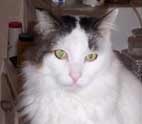
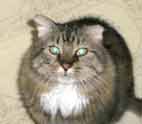
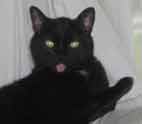
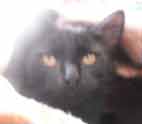
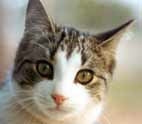
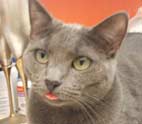
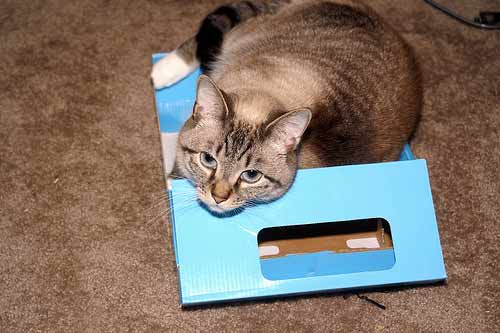
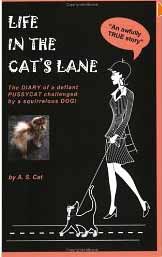 This month the prize will be a signed copy of "Life In the Cats Lane. So get your thinking caps on and enter the competition.
This month the prize will be a signed copy of "Life In the Cats Lane. So get your thinking caps on and enter the competition.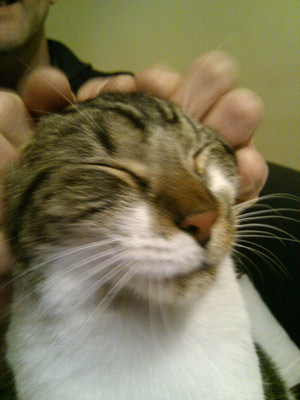 Shelley is a simple cat with simple pleasures. As long as there is food in his tummy a comfy cushion to sit on and an obliging hand to tickle his head he is a happy cat.
Shelley is a simple cat with simple pleasures. As long as there is food in his tummy a comfy cushion to sit on and an obliging hand to tickle his head he is a happy cat.